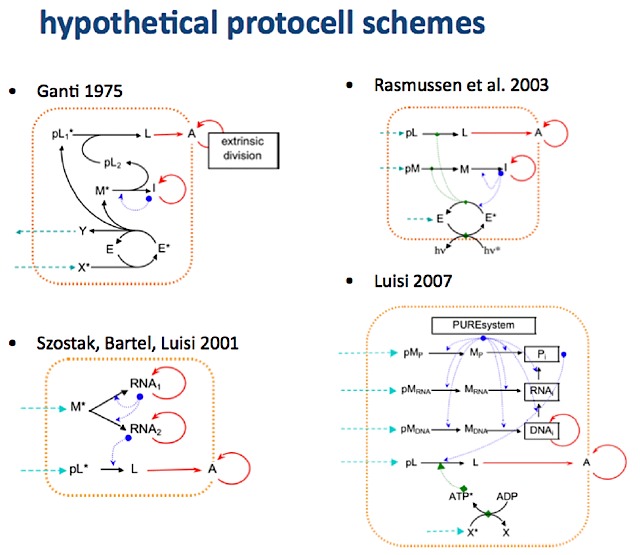Examples of architectures for artificial cells

Upper left: The chemoton (Ganti, 1975; Griesemer and Szathmary, 2008) couples a metabolism with a genetics and containment. Lower right: The RNA cell (Szostak et al., 2001; Hanczyc et al., 2008). A vesicle encapsulates two RNA ribozymes; one (RNA1) acts as a polymerase (RNA replicase) and facilitates the replication of both RNA strings, and the other (RNA2) catalyzes the production of lipids (L) from appropriate activated precursors (pL*). Upper right: Los Alamos bug (Rasmussen et al., 2003; Rasmussen et al., 2008b). Light energy is harvested by a sensitizer ( E), and this energy is used in the production of monomer components ( M) of genetic molecules ( I ) from precursors (pM). The energy is also used to convert precursor lipids ( pL) into lipids ( L). These lipids self-assemble into a micelle or vesicle aggregate (A). Genetic molecules catalyze both the metabolic cycle and the production of further genetic molecules. The continual production of lipids causes the aggregate to grow and ultimately divide. Lower right: The protein/DNA cell (see Stano et al., 2008). The metabolism extracts energy from an energized food source (X) to produce ATP*, which drives all the chemical reactions in the cell. Those reactions ultimately produce various kinds of DNA, RNA, and proteins (DNAi, RNAi, and Pi) from their components (MDNA, MRNA, MP), which in turn are produced by their precursors (pMDNA, pMRNA, pMP) lodged in vesicle membranes.
